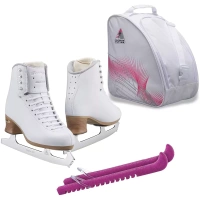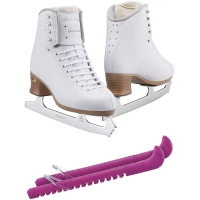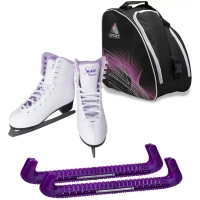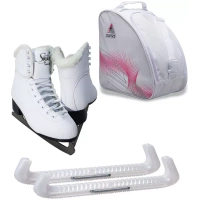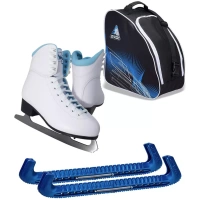If you are more than an occasional figure skater, you should know that proper care of your ice skates is the key to their long life as well as to your high performance, because breaking into a new pair of figure or hockey skates takes time and is always a step back in your practice.
Proper ice skates maintenance includes the basic steps you should follow regularly as well as long-term actions and decisions such as choosing the right size, sharpening the blades and monitoring the mount and screws.
After each session
Always wipe and dry the blades after skating to avoid rusting. Remove the dust and moisture from the boots with a microfiber or cotton cloth. In a hurry, use some odor absorbers. They are not only supposed to elicit the excess odors, but also absorb the excess moisture.
Remember to wipe the boots inside as well, as the moisture and bacteria from your sweat can cause mold, mildew and even rotting of the leather.
There are different fits offered by different companies. If you are a size 10 in one brand, you might fit into size 9 or 8.5 in another one. It comes from the differences in the skate width, toe width, the depth of the skate, the volume in the heel, etc.
Here are some vital tips to find the right hockey skate fit.
At the hockey skate fitting, you should wear the socks you are going to wear for the practice and games. If your heel is moving or you can lift it, that means that the skate doesn’t fit well and your performance will suffer. The skate should fit snug and provide support to your feet. It enables a good push-off without unnecessary movement of the foot inside the skate.
It takes some time to break into new ice skates. Heat fitting is a great option that facilitates the break-in process and helps get a proper hockey skate fit. The skates are baked in a special oven to round out the stiff sides and the boots’ upper part. This way, they take the shape of the player’s feet and ensure a proper hockey skate fit. Heat molding your hockey skates shortens the break-in time by about a half.
When you get back home, take your skates out of the skating bag and put them in a dry, cool room. Take off the covers and foot soles to dry out as well. The skates should dry overnight before you return to the ice rinks.
Before putting away the boots, place the tongue in an upright position. If you leave it distorted, it will take the shape you left it in. Do not forget to loosen the laces before taking off the boots. The ones with the instant shaping feature will shrink as they cool down from 37°C.
To cover scratches, use shoe polish or a special polish for ice skates.
Occasional care
The insoles should be changed regularly. During regular skating sessions, they crook and warp, which also causes bacteria growth and unpleasant odors.
You should also change your laces as soon as they lose their texture and elasticity, or every three to four months. Safety should always come first. Even if there are a little wear and tear, you shouldn’t take any risk and should replace them.
Skate sharpening is a crucial part of ice skate care routine. A sharp blade grabs the ice and gives the skater better control over deep edges and maximizes the push. Well-sharpened blades ensure easy and consistent skating when it comes to jumps and spins. If you want to trust your blades and show your best performance at competitions, you should figure out your individual interval between sharpenings. Keep a log of the time you spend skating between sharpenings. After a while, you will know how long your blades last and avoid surprises when you want to perform at your best. You should find a trusted skate care expert to sharpen your skates, who will know your preferences and do a good job. You don’t want to take risks since a pair of good ice skates can be pricy and also hard to break in.
You can learn more about how the process of sharpening works and how often you should sharpen the skates, here.
General advice on any type of skate maintenance
Your performance on the ice depends a lot on the condition of blades. Keep the edges in good condition as you step off the ice.
The blades need to be protected from grain and dirt that sticks to them on your way between the locker room and the ice skating rinks. All this stuff is a threat to your blades. You can purchase skate guards at a skate shop. Wearing them will also mean less frequent sharpening and will significantly increase the life of your blades.
When stored, the blades also need to be covered, as their sharp edges can damage your stuff or accidentally give you cuts. Make sure to replace the blade guards when necessary, and keep them in good condition.
Last but not least, you should pay attention to the way you lace the ice skates. Proper lacing is key to maintaining the boot’s durability. Lace the skates tightly and use tongue hooks if your skates have them. Improper lacing can lead to movement in your boot and cause stress to the boot – hence its premature breakdown.
Make sure all the eyelets and hooks are functioning, and the laces are firm, and there are no tears. Change them regularly, as soon as you notice small tears or they lose tightness and elasticity.
